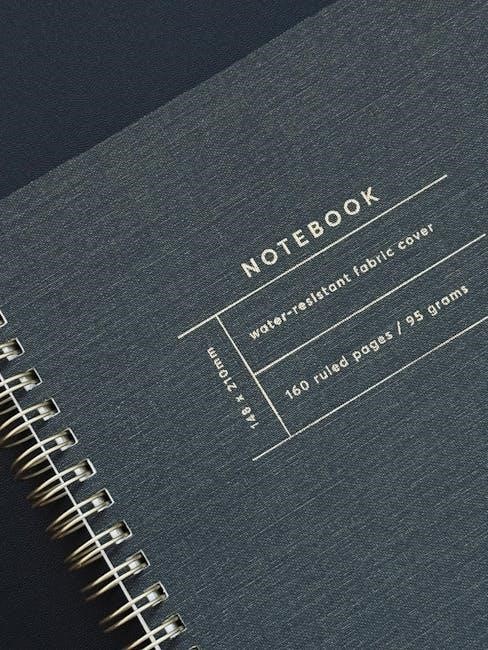Choosing the right planner size is essential for maximizing productivity and efficiency. With various options like A4, Letter, A5, and Personal sizes, understanding their differences helps tailor your planning system to your needs, ensuring a balance between portability and writing space.
1.1 Importance of Choosing the Right Planner Size
Selecting the appropriate planner size is crucial for productivity and efficiency. The right size ensures comfort, portability, and sufficient writing space. A planner that is too large may be cumbersome, while one that is too small can limit functionality. Understanding your needs helps in balancing portability with usability. Mixing paper sizes can lead to inconsistencies, so compatibility is key. Choosing the right size enhances organization and personalization, making your planning system more effective and enjoyable.
1.2 Overview of Common Planner Sizes
Planners come in a variety of sizes to suit different needs and preferences. Common sizes include A4, Letter, A5, Half Letter, Personal (A6), Pocket, and Mini. Each size offers unique benefits, from the spacious A4 for detailed planning to the portable Mini for on-the-go use. Understanding these options helps users choose the perfect fit for their lifestyle, whether they prioritize writing space, portability, or a balance between both. This overview provides a clear starting point for selecting the ideal planner size.
Common Planner Sizes
Planners come in various sizes, including A4, Letter, A5, Half Letter, Personal (A6), Pocket, and Mini, each offering unique benefits for organization and portability needs.
2.1 A4 and Letter Size Planners
A4 and Letter size planners are the largest options, offering ample space for detailed planning. A4, used globally, measures 8.27″ x 11.7″, while Letter size, common in the US, is 8.5″ x 11″. Both sizes are ideal for those needing extensive writing space, though A4 is slightly taller and narrower. These planners are perfect for desk use, allowing for elaborate layouts and notes, and are widely compatible with standard 3-ring binders or discbound systems, making them versatile and easy to find.
2.2 A5 and Half Letter Size Planners
A5 and Half Letter planners strike a balance between portability and usability. A5, measuring 5.83″ x 8.27″, is popular outside the US, while Half Letter, at 5.5″ x 8.5″, is its US counterpart. Both sizes are ideal for everyday use, offering enough space for writing without being bulky. They fit well in bags and are compatible with 6-ring binders, like Filofax, or discbound systems. These planners are versatile, accommodating various layouts, and are a favorite among those seeking practicality and style in their planning systems.
2.3 Personal (A6) Size Planners
Personal (A6) size planners, measuring 4.15″ x 5.83″, are ideal for those seeking ultimate portability. Popularized by Filofax, these compact planners are perfect for minimalists who need a small, lightweight option. They offer enough space for daily tasks or notes without being bulky. A6 planners typically use a 6-ring binder system and require a specific punch for compatibility. While less common than A5, they are beloved for their sleek design and ease of carrying, making them a great choice for on-the-go planning.
2.4 Pocket and Mini Size Planners
Pocket and Mini size planners are perfect for minimalists and those needing extreme portability. Pocket planners measure 3.19″ x 4.72″, while Mini planners are even smaller at 2.64″ x 4.13″. These sizes are ideal for quick notes and on-the-go planning, though they offer limited writing space. Filofax popularized these sizes, offering binders with 6-ring systems. Despite their compact nature, they remain functional for simple planning needs, appealing to those who prioritize ease of carrying over extensive writing space.
Understanding Planner Measurements
Planner measurements vary, with A4 (8.27×11.7″) and Letter (8.5×11″) being the largest, while Personal (3.74×6.73″) and Pocket (3;19×4.72″) offer compact options for portability and simplicity.
3.1 A4 vs. Letter Size: Key Differences
A4 (8.27×11.7″) and Letter (8.5×11″) sizes are widely used but differ slightly. A4 is taller and narrower, while Letter is shorter and wider, making them nearly interchangeable for printing. Both sizes are ideal for full-size planners, offering ample writing space. A4 is common outside the U.S., while Letter dominates in the U.S., with binders and punches readily available. Their slight size difference ensures compatibility, but mixing them in one planner may look inconsistent.
- A4: 8.27″ x 11.7″ (taller and narrower)
- Letter: 8.5″ x 11″ (shorter and wider)
Both sizes are popular for 3-ring or discbound systems, offering flexibility and functionality for organized planning.
3.2 A5 vs. Half Letter Size: What You Need to Know
A5 (5.83×8.27″) and Half Letter (5.5×8.5″) sizes are similar but distinct. A5 is slightly wider and shorter, while Half Letter is narrower and taller. Both are popular for mid-sized planners, offering ample writing space. A5 is widely used outside the U.S., while Half Letter is common in the U.S. They are interchangeable in most binders, but mixing sizes in one planner may look inconsistent. A5 is ideal for Filofax and Kikki K binders, while Half Letter works well with the Sweet Life Planner.
- A5: 5.83″ x 8.27″ (wider and shorter)
- Half Letter: 5.5″ x 8.5″ (narrower and taller)
Both sizes are versatile, but choosing one depends on your planner brand and personal preference.

Choosing the Right Size for Your Needs
Selecting the ideal planner size depends on your lifestyle, portability needs, and writing preferences. Consider how much space you require and how often you’ll carry your planner.
4.1 Portability vs. Writing Space
Portability and writing space are key factors in choosing a planner size. Smaller sizes like A6 or pocket planners are ultra-portable but offer limited writing space, ideal for jotting quick notes. Larger sizes, such as A4 or Letter, provide ample room for detailed planning but are less convenient to carry. Balancing these aspects ensures your planner fits seamlessly into your daily routine, whether you’re on-the-go or need extensive space for organizing.
4.2 How to Decide Based on Usage
Deciding on a planner size based on usage involves assessing your primary needs. If you require detailed daily layouts, larger sizes like A4 or Letter are ideal; For simplicity and portability, A5 or Half Letter sizes are practical. Personal or Pocket sizes are great for minimalists focusing on essentials. Consider how you’ll use your planner—whether at a desk, on-the-go, or for specific tasks—to select a size that aligns with your lifestyle and productivity goals, ensuring it enhances your organizational system effectively.

Binding Systems and Compatibility
Planner binding systems vary, with 3-ring, 6-ring, and discbound options. Compatibility depends on paper size, with 6-ring systems often requiring specific punches. Mixing sizes can cause misalignment, affecting aesthetics and functionality; Choose a system that aligns with your planner size and personal preference for a seamless organizing experience.
5.1 3-Ring vs. 6-Ring Binders
3-ring and 6-ring binders differ in functionality and compatibility. 3-ring binders are widely available and suitable for standard letter or A4 sizes, while 6-ring systems offer more secure page holding, ideal for A5 and personal sizes. Both require specific punches, with 6-ring punches often needed for smaller planners. While 3-ring systems are more common, 6-ring binders provide better durability and organization, especially for detailed planning. However, they may limit flexibility if mixing paper sizes.
5.2 Discbound Systems: Pros and Cons
Discbound systems offer exceptional flexibility and customization. Pages can be easily added or removed without bulky rings, and the slim design allows for a compact planner. Popular among enthusiasts, these systems are compatible with various sizes, including A5 and half-letter. However, they require specific punches, which can be an initial investment. The ability to mix sizes, though possible, may result in uneven page alignment. Despite this, discbound systems are favored for their sleek appearance and versatility in creating personalized planning setups.

Mixing Paper Sizes in One Planner
Mixing paper sizes in one planner is possible but may result in uneven alignment. While functional, it can look inconsistent, affecting the planner’s aesthetic and usability.
6.1 Pros of Using Multiple Sizes
Mixing planner sizes offers flexibility and customization. Larger pages provide ample writing space, while smaller ones save on bulk. This setup allows for organizing different content types effectively, enhancing productivity and personalization.
6.2 Cons and Tips for Mixing Sizes
Mixing planner sizes can lead to uneven page alignment, creating a messy look. Smaller pages may protrude, affecting aesthetics. To avoid issues, use compatible punches for consistent hole spacing. Consider cutting paper to size rather than mixing for a uniform appearance. Ensure binders accommodate varying sizes without bulging. Careful planning and attention to compatibility are key to maintaining functionality and visual appeal when combining different planner sizes.
Customization Options
Customizing your planner enhances functionality and personal style. DIY printing allows tailored layouts, while punching tools enable easy insertion of custom pages. Inserts and stickers offer creative ways to personalize your space, making your planner truly unique and functional for your needs.
7;1 DIY Printing and Punching
DIY printing and punching offer endless customization possibilities for your planner. By printing your own inserts, you can tailor layouts to suit your needs. Punching tools, like 6-ring or disc punches, allow seamless integration of these custom pages. This approach not only saves money but also ensures your planner reflects your personal style. Many users prefer this method for its flexibility and precision in creating a system that aligns perfectly with their organizational goals, enhancing both functionality and aesthetics.
7.2 Using Inserts and Stickers
Inserts and stickers are fantastic for personalizing your planner and enhancing its functionality. Pre-designed inserts, such as calendars, to-do lists, and budget trackers, save time and streamline organization. Stickers add a creative touch, making your planner visually appealing while marking important dates or tasks. They also help categorize and prioritize activities, boosting productivity. Experiment with different styles and layouts to find what works best for you, ensuring your planner remains both functional and aesthetically pleasing. Start with minimal designs and build as you discover your preferences.
Choosing the right planner size is a personal journey that balances portability, writing space, and functionality. Reflect on your lifestyle and needs to select a size that complements your daily routine. Experiment with customization options like inserts and stickers to enhance productivity and aesthetics. Remember, there’s no one-size-fits-all solution—mixing sizes or adjusting layouts can refine your system. Stay organized, embrace creativity, and enjoy the process of tailoring your planner to perfectly suit your unique preferences and goals.
